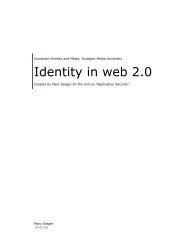The current state of anonymous file-sharing - Marc's Blog
The current state of anonymous file-sharing - Marc's Blog
The current state of anonymous file-sharing - Marc's Blog
You also want an ePaper? Increase the reach of your titles
YUMPU automatically turns print PDFs into web optimized ePapers that Google loves.
(or a selective amount <strong>of</strong> neighbors if there is more information available that can help<br />
diminish the possible targets <strong>of</strong> the search request). This approach is a form <strong>of</strong> breadth-<br />
search<br />
<strong>The</strong> random walk approach is a depth-search based way <strong>of</strong> only forwarding messages to<br />
one neighbour. Most <strong>of</strong> the time, a node in the network knows its direct neighbors and<br />
is able to direct the message according to meta-information to a specific neighbor.<br />
<strong>The</strong> flooding approach guarantees to be able to find a certain node on a given network,<br />
but has to deal with a lot <strong>of</strong> overhead in the process, the random walk approach can’t<br />
guarantee that a certain node will be found and expects every node to store information<br />
about the surrounding nodes, but also has less overhead.<br />
4.1.4 <strong>The</strong> new kid on the block: Structured Peer-to-Peer networks<br />
A lot <strong>of</strong> the recent "big" <strong>file</strong>-<strong>sharing</strong> networks were unstructured, meaning that they<br />
relied more or less on some form <strong>of</strong> broadcasting for search-operations because they<br />
don’t know much about the topology <strong>of</strong> the network they participate in. Joining an<br />
unstructured network means creating an arbitrary connection to other whichever node<br />
a client can get information about. In an unstructured P2P network, if a peer wants<br />
to find a unique piece <strong>of</strong> data, the query has to be flooded through the network in an<br />
attempt to reach as many peers as possible that might share the data. This can lead to<br />
search-queries without any ”hits”, although the data is in fact somewhere in the network.<br />
Popular content will show up at more than one peer a search query will result in many<br />
”hits”. Search queries for very rare data on the other hand are unlikely to be able to<br />
receive any results.<br />
Structured P2P networks use a protocol that ensures that search requests are automat-<br />
ically routed to a node serving the <strong>file</strong> that is searched for, even if it is a "one in a<br />
million" type <strong>of</strong> situation. To be able to do this and still scale, you can’t go on and have<br />
peers randomly connect to other peers and broadcast their searches. A solution to give<br />
the network the needed structure lies in the use <strong>of</strong> a distributed hash table (DHT) that<br />
usually uses some form <strong>of</strong> consistent hashing to assign ownership <strong>of</strong> a <strong>file</strong> to a particular<br />
peer on the network. This results in every <strong>file</strong> having a logical position on a node in the<br />
network.<br />
Currently there are two ways <strong>of</strong> implementing this way <strong>of</strong> content organization:<br />
• structured search<br />
9



